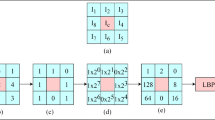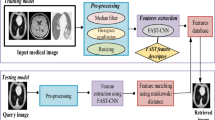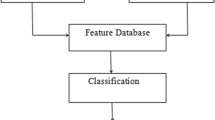Abstract
Recently, Content-based medical image retrieval (CBMIR) systems enable fast diagnosis via the assessment of the visual information in medical application. Most of the state-of-the-art CBMIR systems facing few issues: computationally expensive due to the usage of high dimensional feature vectors and complex classifier/clustering approaches. The reasons behind this are, inability to properly handle the “semantic gap” and the high intra-class versus inter-class variability problem of the medical image database (like radiographic image database). This yields a crucial demand for developing computationally efficient and highly effective retrieval system. For this purpose, the present study proposed an efficient retrieval system which has a four-fold: First, pre-processing and Feature extraction of input image using canonical correlation analysis (CCA). By this approach extracted the feature in both pixel and feature domains and examined more rigorously. Second, applied Fuzzy C means clustering of pixel intensity values as features based on the singular value decomposition. Through this can grouping, the image based on the pixel intensity value. Third, deep convolutional neural network with SVM classifier which makes implementable and requires only a compact feature vector representation of the stored database image with their class levels during retrieval. Finally evaluated the performance based on the measure of Mean Average Precision, Correct rate (CR), Error rate (ER), Accuracy. The classification results and learned features are used for the purpose of retrieving the medical images in a database. The proposed retrieval system performs better than the traditional approach in terms of measuring average value of precision, recall, f-measure and accuracy 95.9%, 94.96%, 95.37% and 95.798% respectively. The suggested approach is best suited towards retrieving the medical images for various part of the body.





Similar content being viewed by others
References
Cheng Z, Li X, Shen J, Hauptmann AG (2016) Which Information Sources are More Effective and Reliable in Video Search. In: Proceedings of the 39th International ACM SIGIR conference on Research and Development in Information Retrieval - SIGIR ‘16. ACM Press, New York, pp 1069–1072
Cui C, Lin P, Nie X, Yin Y, Zhu Q (2017) Hybrid textual-visual relevance learning for content-based image retrieval. J Vis Commun Image Represent 48:367–374
Divya BS, Subramaniam K, Nanjundaswamy HR (2018) Human Epithelial Type-2 Cell Image Classification Using artificial network with Hybrid Descriptors. IETE J Res. https://doi.org/10.1080/03772063.2018.1474810
Divya BS, Subramaniam K, Nanjundaswamy HR (2018. ISSN1868-5137) Human epithelial type-2 cell categorization using hybrid descriptor with binary tree. J Ambient Intell Humaniz Comput. https://doi.org/10.1007/s12652-018-0694-6
He K, Zhang X, Ren S, Sun J (2016) Deep Residual Learning for Image Recognition. In: 2016 IEEE Conference on Computer Vision and Pattern Recognition (CVPR). IEEE, pp. 770–8
Hinton G, Deng L, Yu D, Dahl G, Mohamed A, Jaitly N et al (2012) Deep Neural Networks for Acoustic Modeling in Speech Recognition. IEEE Signal Process Mag 29(6):82–97
Hwang KH, Lee H, Choi D (2012) Medical image retrieval: past and present. Healthc Inform Res 18(1):3–9
Jensen R, Shen Q (2009) New Approaches to Fuzzy-Rough Feature Selection. IEEE Trans Fuzzy Syst 17(4):824–838
Kannan SR, Ramathilagam S, Sathya A, Pandiyarajan R (2010) Effective fuzzy c-means based kernel function in segmenting medical images. Comput Biol Med. 40(6): 572–9. Available from: http://linkinghub.elsevier.com/retrieve/pii/S001048251000065X
Karpathy A, Toderici G, Shetty S, Leung T, Sukthankar R, Fei-Fei L (2014) Large-Scale Video Classification with Convolutional Neural Networks. In: 2014 IEEE Conference on Computer Vision and Pattern Recognition. IEEE, pp. 1725–32
Khatami A, Babaie M, Khosravi A, Tizhoosh HR, Nahavandi S (2018) Parallel deep solutions for image retrieval from imbalanced medical imaging archives. Appl Soft Comput 63:197–205
Khatami A, Khosravi A, Lim CP, Nahavandi S (2016) A Wavelet Deep Belief Network-Based Classifier for Medical Images. Neural Information Processing:467–474
Khatami A, Khosravi A, Nguyen T, Lim CP, Nahavandi S (2017) Medical image analysis using wavelet transform and deep belief networks. Expert Syst Appl 86:190–198
Kumar A, Kim J, Cai W, Fulham M, Feng D (2013) Content-based medical image retrieval: a survey of applications to multidimensional and multimodality data. J Digit Imaging 26(6):1025–1039
Kundu MK, Chowdhury M, Das S (2017) Interactive radiographic image retrieval system. Comput Methods Prog Biomed 139:209–220
LeCun Y, Bengio Y, Hinton G (2015) Deep learning. Nature 521(7553):436–444
Li Z, Zhang X, Müller H, Zhang S (2018) Large-scale retrieval for medical image analytics: A comprehensive review. Med Image Anal 43:66–84
Liu A-A, Nie W-Z, Gao Y, Su Y-T (2016) Multi-Modal Clique-Graph Matching for View-Based 3D Model Retrieval. IEEE Trans Image Process 25(5):2103–2116
Lotfabadi MS, Shiratuddin MF, Wong KW (2013) Using fuzzy-rough feature selection for image retrieval system. In: 2013 IEEE Symposium on Computational Intelligence for Multimedia, Signal and Vision Processing (CIMSIVP). IEEE, pp. 42–8.
Muller H, Rosset A, Vallee J-P, Geissbuhler A (2004) Comparing features sets for content-based image retrieval in a medical-case database. In: Ratib OM, Huang HK, editors. p. 99
Nair LR, Subramaniam K (2016) A Review Of Luminance And Color Invariants Based Partial Medical Image Retrieval Systems, Pak. J. Biotechnol. Vol. 13 special issue II (International Conference on Engineering and Technology Systems (ICET’16) Pp. 87–95
Nair LR, Subramaniam K (2018) An Effective Image Retrieval System Using Color, Luminance, Texture with Shape Invariants Features, Journal of Advanced Research in Dynamical & Control Systems, Vol. 10, 11-Special Issue
Nie X, Liu J, Sun J, Wang L, Yang X (2013) Robust video hashing based on representative-dispersive frames. SCIENCE CHINA Inf Sci 56(6):1–11
Nie L, Wang M, Zhang L, Yan S, Zhang B, Chua T-S (2015) Disease Inference from Health-Related Questions via Sparse Deep Learning. IEEE Trans Knowl Data Eng 27(8):2107–2119
Paulraj MP, Subramaniam K, Yaccob SB, Hamid A, Adom B, Hema CR (2014) A Machine learning approach for distinguishing hearing perception level using auditory evoked potentials. In 2014 IEEE EMBS Conference on Biomedical Engineering and Sciences (IECBES), Malaysia, pp. 991–6
Qayyum A, Anwar SM, Awais M, Majid M (2017) Medical image retrieval using the deep convolutional neural network. Neurocomputing. 266:8–20
Quellec G, Lamard M, Cazuguel G, Cochener B, Roux C (2010) Wavelet optimization for content-based image retrieval in medical databases. Med Image Anal 14(2):227–241
Rahman M, Antani S, Thoma G (2011) A Learning-Based Similarity Fusion and Filtering Approach for Biomedical Image Retrieval Using SVM Classification and Relevance Feedback. IEEE Trans Inf Technol Biomed 15(4):640–646
Rasiwasia N, Mahajan D, Mahadevan V, Aggarwal G (2014) Cluster Canonical Correlation Analysis. In: Proceedings of the 17th International Conference on Artificial Intelligence and Statistics. Reykjavik: AISTAT, pp. 823–31. Available from: http://proceedings.mlr.press/v33/rasiwasia14.pdf
Scott G (2007) Chi-Ren Shyu. Knowledge-Driven Multidimensional Indexing Structure for Biomedical Media Database Retrieval. IEEE Trans Inf Technol Biomed 11(3):320–331
Sermanet P, Eigen D, Zhang X, Mathieu M, Fergus R, LeCun Y (2013) OverFeat: Integrated Recognition, Localization and Detection using Convolutional Networks
Sree Sharmila T (2014) Efficient analysis of satellite image denoising and resolution enhancement for improving classification accuracy
Subrahmanyam M, Maheshwari RP, Balasubramanian R (2012) Local maximum edge binary patterns: A new descriptor for image retrieval and object tracking. Signal Processing. 92(6): 1467–79. Available from: http://linkinghub.elsevier.com/retrieve/pii/S0165168411004361
Velmurugan K, Baboo LDSS (2011) Image retrieval using Harris corners and his- togram of oriented gradients. Int J Comput Appl 24: 6–10. Available from: https://pdfs.semanticscholar.org/e892/44816864ee8e000b72923b1983af6c65adb8.pdf
Wan J, Wang D, Hoi SCH, Wu P, Zhu J, Zhang Y et al (2014) Deep Learning for Content-Based Image Retrieval. In: Proceedings of the ACM International Conference on Multimedia - MM ‘14. ACM Press, New York, pp 157–166
Wasinphongwanit P, Phokharatkul P (2010) Image retrieval using contour feature with the rough set method. In: 2010 International Conference on Computer, Mechatronics, Control and Electronic Engineering. IEEE
Wu G, Lu W, Gao G, Zhao C, Liu J (2016) Regional deep learning model for visual tracking. Neurocomputing 175:310–323
Zeiler MD, Fergus R (2014) Visualizing and Understanding Convolutional Networks. In: Proceedings of the European Conference on Computer Vision, pp. 818–33
Zhao S, Tsang E, Chen D (2009) The Model of Fuzzy Variable Precision Rough Sets. IEEE Trans Fuzzy Syst 17(2):451–467
Zhou S, Chen Q, Wang X (2013) Active deep learning method for semi-supervised sentiment classification. Neurocomputing 120:536–546
Author information
Authors and Affiliations
Corresponding author
Additional information
Publisher’s note
Springer Nature remains neutral with regard to jurisdictional claims in published maps and institutional affiliations.
Rights and permissions
About this article
Cite this article
Nair, L.R., Subramaniam, K. & Venkatesan, G.K.D.P. An effective image retrieval system using machine learning and fuzzy c- means clustering approach. Multimed Tools Appl 79, 10123–10140 (2020). https://doi.org/10.1007/s11042-019-08090-2
Received:
Revised:
Accepted:
Published:
Issue Date:
DOI: https://doi.org/10.1007/s11042-019-08090-2




